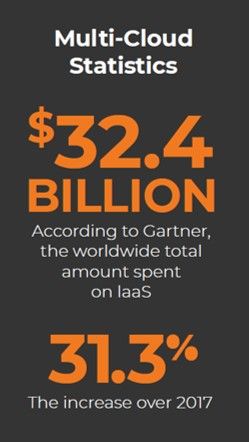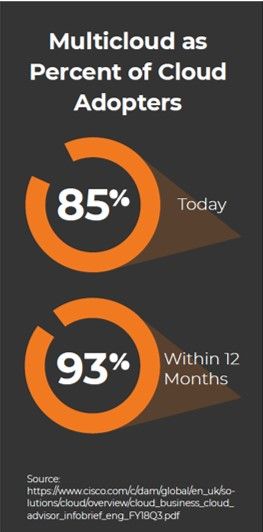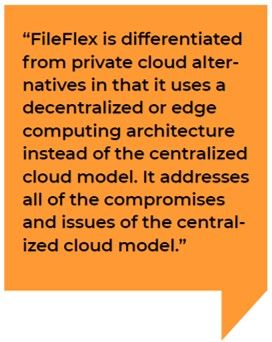
Infrastructure-as-a-Service and a hybrid-IT multi-cloud environment adds layers of complexity to your IT infrastructure. IT has learned to handle the complexity and the vendors have provided the tools to manage it, but what about tools for the end-users. Sadly, these are lacking. This blog looks at the needs of your end-users, security concerns, issues of a virtual private cloud implementation and finally using the decentralized or edge architecture of FileFlex Enterprise to provide secure remote file access and file sharing cloud-hosted/multi-cloud storage while improving your security posture and allowing access to all storage.
How to Make Your Hybrid-IT and Infrastructure-as-a-Service Environment Easier for Your Users
OK – so your organization has a hybrid-IT multi-cloud environment and uses Infrastructure-as-a-Servic e providers such as Amazon S3, Microsoft Azure and Google Cloud. Maybe this was intentional, maybe it was ad hoc – and now you have to support both it and your users. The problem is that multi-cloud has added layers of complexity to your IT infrastructure. You and your team are pretty good at handling the technical complexity, but no so for your users. How can you make your hybrid-IT and Infrastructure-as-a-Service storage easier to navigate and operate for the average user?
e providers such as Amazon S3, Microsoft Azure and Google Cloud. Maybe this was intentional, maybe it was ad hoc – and now you have to support both it and your users. The problem is that multi-cloud has added layers of complexity to your IT infrastructure. You and your team are pretty good at handling the technical complexity, but no so for your users. How can you make your hybrid-IT and Infrastructure-as-a-Service storage easier to navigate and operate for the average user?
What is the Hybrid-IT and How is it Different from a Hybrid Cloud?
We should note here the difference between ‘hybrid-IT’, 'multi-cloud' and hybrid cloud'.
Hybrid Cloud – A hybrid cloud environment is when an organization uses a combination of public/EFSS cloud and private cloud. For example, they may store their confidential and sensitive information in a private cloud, but in order to reduce costs, store normal business information in a public or EFSS cloud. This is a hybrid cloud environment.
Multi-Cloud – A multi-cloud environment is when an organization uses the cloud facilities and services of multiple Infrastructure-as-a-service (IaaS) vendors. For example, for various reasons they may use Amazon AWS, Microsoft Azure and Google Cloud. They then have a multi-cloud environment.
Hybrid-IT – A hybrid-IT environment is when an organization uses the a combination of on-premises and cloud-hosted infrastructure from Infrastructure-as-a-service (IaaS) vendors such as Amazon AWS, Microsoft Azure and Google Cloud.
Make Hybrid IT and Multi-Cloud Easier for Your Users
IaaS providers have great tools for IT
Most IT leaders have brought in the tools that they need to manage their hybrid-IT and multi-cloud environments from a technical perspective. They have bought the deployment, migration and management tools they need for provisioning and orchestration; service request management; inventory and classification; monitoring and analytics; cost management and resource optimization; cloud migration, backup and disaster recovery; and identity, security and compliance.
IaaS have poor or no tools for end users
Tools provided by IaaS and mutlicloud vendors to help users navigate and use this complex environment are sadly lacking.
Remote access and sharing – IaaS and cloud-hosted multi-cloud providers essentially act like your own on-premises server/storage infrastructure, except that they are located and hosted in a third-party datacenter – like Google, Amazon of Microsoft. As such, they generally do not have any native remote access and sharing capability.
Cut, copy, paste and general file management – IaaS and cloud-hosted multi-cloud providers have no end-user file management capability like cut, copy, paste, rename etc. They have management utilities for IT such as AzCopy, AWS Explorer and Google Cloud Shell, but are not equipped for end-users.
Tips for Securing Your Hybrid-IT and Multi-Cloud Environment
 In the same way that having a hybrid-IT multi-cloud architecture means securing a multi-cloud architecture and having easy end-user access to your multi-cloud storage means securing their access.
In the same way that having a hybrid-IT multi-cloud architecture means securing a multi-cloud architecture and having easy end-user access to your multi-cloud storage means securing their access.
To be successful in securing communications for end-user access, you’ll need to develop a multilayered strategy that makes use of technologies that secure both applications and data. You’ll need to consider controls for user access that work across cloud boundaries. Normally, it is the responsibility of the cloud provider to secure their infrastructure, and they will or should be able to provide you some of the capabilities you need in order to protect your data while it's in their facility. But what about the third-party applications you are using in that infrastructure such as providing remote access to cloud storage for your users. Those applications need security capabilities such as multi-factor authentication, encryption, virus scanning, active directory integration, SSO and identity and access management, device authentication, credential protection and an activity log for incident management.
What About Building a Virtual Private Cloud?
One way to allow end-user access to our multi-cloud or Infrastructure-as-a-Service storage is to use it to build a virtual private cloud. A virtual private cloud is when you host your private cloud on your Infrastructure-as-a-Service provider. All private clouds all sync or copy to a centralized cloud server cluster that is located with the Infrastructure-as-a-Service provider.
Subsets
Since many users and devices sync or store information on the centralized server cluster and because that server has limited storage, only a subset of an organizations overall data can be stored. That means that users will have to manage their allotment and often critical data will not be on that server and is unavailable.
Technical Challenges
Building and maintaining a virtual private cloud requires expert knowledge and staffing that your current IT team may not possess and will present a great number of technical challenges.
If you do not have accomplished private cloud experts on your team it can be extremely challenging to get your virtual private cloud project off the ground. Your IT department needs be big enough with enough expertise and if you do not do it right at the early stages of a deployment, things might break later.
Use FileFlex Enterprise to Make Your Hybrid-IT Multi-Cloud Easier for Your Users
FileFlex is differentiated from private cloud alternatives in that it uses a zero trust hybrid-IT architecture instead of the centralized cloud model. It leverages the CPU power and storage of the end-point devices who communicate directly with each other. The central server acts like a switchboard to facilitate a hybrid point-to-point connection and as a policeman to enforce policies. Data is stored in source locations which all now have cloud functionality of remote access, sharing, streaming, remote editing and file management. Privacy and confidentiality can be protected by keeping data in source locations, on-premises, behind the corporate firewall, on corporate storage assets, in specific geographic regions and access controlled. Also, with this technology users can access all storage not just a subset that is duplicated to a central server. And because it leverages your Infrastructure-as-a-Service storage, organizations do not have to build a virtual private cloud.
Using FileFlex as a client to access and share your cloud-hosted multi-cloud storage is actually very simple. FileFlex puts all your cloud platforms and on-premises storage under a single-pane-of-glass – or on the same dashboard. It simply treats each cloud provider as a content repository.
Functionality FileFlex Enterprise adds to a hybrid-IT multi-cloud environment
Use FileFlex to add the following functionality to our multi-cloud and Infrastructure-as-a-Service providers:
1) Add end-user remote access capability to your multi-cloud
FileFlex provides users remote access to the files and folders stored on your multi-cloud and Infrastructure-as-a-Service environment. Access can be from a Windows, Mac or Linux computer; Android, iOS, BlackBerry or Windows tablet or smart phone; or any internet connected kiosk. The access to all storage is from a simple dashboard.
2) Add robust file sharing to your multi-cloud
Remotely share files stored on your multi-cloud or Infrastructure-as-a-Service cloud without having to sync, move, duplicate or upload them to a public or EFSS cloud by providing shared access to where they are saved. FileFlex does not use sharing links that can be forwarded or copied to social media. Instead it is permission-based access to source locations. The technology of FileFlex makes files and folders shared act like an extension of the recipient's local device. There are no storage limitations, no file size limits, no quality degradation (no compression) and no complicated IT type setup requirements for the sharing of files.
3) Add remote file management to your multi-cloud
Use any internet connected smart phone, tablet or secondary computer to remotely cut, paste, copy, delete, rename, move and organize any document stored on your multi-cloud or Infrastructure-as-a-Service environment. Even cut, copy and paste files between cloud providers or between your on-premise storage remotely. Users don't have to be at home or in the office to organize files, they can keep things organized from anywhere. Supports Amazon S3, Microsoft Azure and Google Storage.
4) Turn your multi-cloud into a remote file editing platform
Enables file editing content collaboration for individuals and teams inside and outside the organization from multi-cloud or Infrastructure-as-a-Service source locations without duplicating or syncing confidential content to a secondary location or a third-party server. Activity tracking, audit trail, version control, file locking, a unified workflow across devices, and simple, secure access make teams more productive and protects organizational information.
5) Add media streaming to your multi-cloud
FileFlex allows you or any contact to stream media files from your multi-cloud and Infrastructure-as-a-Service storage. This allows the consumption and sharing of massive collections of digital media right from this environment in a way that is simply not possible using traditional public, private or EFSS cloud technology. Users stream directly from your IaaS storage.
6) Add automatic backup of photos and videos to your multi-cloud
Automatically back up the photos and videos from as many smart phones and tablets as you want to your multi-cloud or IaaS storage.
7) Add enhanced security to your multi-cloud
In addition to its zero-trust secure platform, FileFlex adds AES 256 encrypted hybrid point-to-point communication, optional double-encryption, U2F universal two-factor authentication, device authentication, virus scanning, single sign-on (SSO) and active directory integration for a much lower risk posture when using multi-cloud or Infrastructure-as-a-Service cloud providers.
8) Add activity logging and enhanced incident management to your multi-cloud
FileFlex logs all activities – even for in-app activities via multi-clouds and Infrastructure-as-a-Service clouds – for audit and regulatory compliance issues. Know what files have been shared from your Amazon S3, Microsoft Azure and Google Cloud services and when. Know who shared what files and when. Know who accessed shared files and when, and know who downloaded shared files and when. For operations and incident management the audit log of activities can be exported and then imported using the common import protocols to the most popular risk management systems.
9) Enhance the privacy of your multi-cloud and prohibit downloading
FileFlex allows you to set your sharing options so that downloading is not permitted. As a result, no unauthorized copies are made of your files and you maintain control over the privacy of the files that are shared from your multi-cloud or Infrastructure-as-a-Service storage. Thus, when your cloud storage complies with data residency requirements and is accompanied with appropriate user behavior, FileFlex can be used for the sharing of Personally Identifiable Information (PII) and aid compliance to privacy regulations such as HIPAA and GDPR because downloading of PII can be prohibited.
10) Add IT control over user activity in your multi-cloud
Users of FileFlex Enterprise can download the free FileFlex server and IT is in complete control over secure remote access and sharing and user activity in your multi-cloud and Infrastructure-as-a-Service storage. IT controls who is provisioned, who they can share with, how much bandwidth they can consume and what content and storage they can access. It is easy to deploy, easy to integrate, scalable, easy to manage, supports multiple locations and all storage options. And they can have it up and running in just a couple of hours.
11) Use FileFlex as a migration tool
Not only is FileFlex an easy tool to provide file management between cloud platforms for your end users, you will find it a great tool that IT can use for both data migration between on-premises storage and servers and their cloud providers and even from one cloud platform to another. From a single dashboard, you can cut, copy, paste, delete and rename files or folders of any size using the hybrid-IT technology of FileFlex. You do not have to use the cloud providers proprietary migration tools or download then upload to an intermediate location first. File size does not matter – the files and folders can be huge. You are only limited by your own storage capacity.
Get the full whitepaper.
How to Make Your Multi-Cloud and Infrastructure-as-a-Service Environment Easier for Your Users